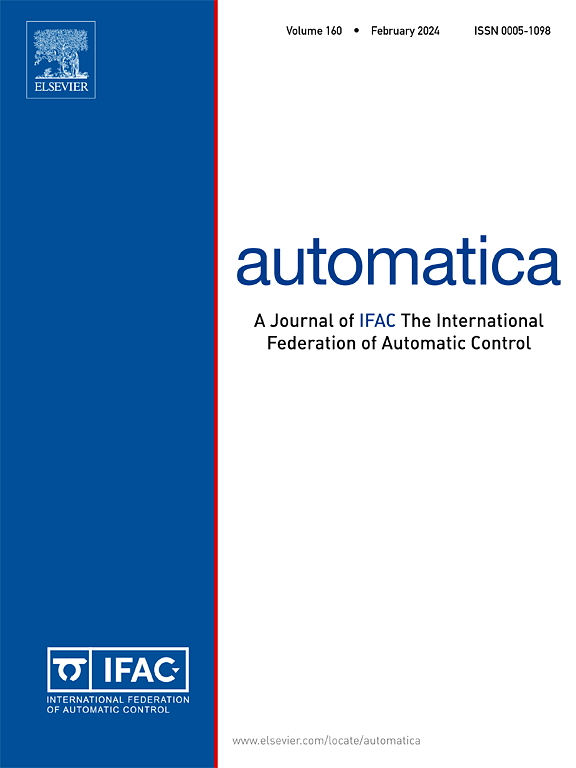Dominance regions of pursuit-evasion games in non-anticipative information patterns
IF 4.8
2区 计算机科学
Q1 AUTOMATION & CONTROL SYSTEMS
引用次数: 0
Abstract
The evader’s dominance region is an important concept and the foundation of geometric methods for pursuit-evasion games. This article mainly reveals the relevant properties of the evader’s dominance region, especially in non-anticipative information patterns. We can use these properties to research pursuit-evasion games in non-anticipative information patterns. The core problem is under what condition the pursuer has a non-anticipative strategy to prevent the evader leaving its initial dominance region before being captured regardless of the evader’s strategy. We first define the evader’s dominance region by the shortest path distance, and we rigorously prove for the first time that the initial dominance region of the evader is the reachable region of the evader in the open-loop sense. Subsequently, we prove that there exists a non-anticipative strategy by which the pursuer can capture the evader before the evader leaves its initial dominance region’s closure in the absence of obstacles. For cases with obstacles, we provide a counter example to illustrate that such a non-anticipative strategy does not always exist, and provide a necessary condition for the existence of such strategy. Finally, we consider a scenario with a single corner obstacle and provide a sufficient condition for the existence of such a non-anticipative strategy. At the end of this article, we discuss the application of the evader’s dominance region in target defense games. This article has important reference significance for the design of non-anticipative strategies in pursuit-evasion games with obstacles.
非预期信息模式下追逐-逃避博弈的优势区域
逃避者的优势区域是追逃博弈几何方法的一个重要概念和基础。本文主要揭示了逃避者优势区的相关特性,特别是在非预期信息模式下。我们可以利用这些属性来研究非预期信息模式下的追逃博弈。核心问题是,在何种条件下,追捕者采取非预期策略来阻止逃避者在被捕获前离开其初始优势区域,而不管逃避者采取何种策略。首先用最短路径距离定义了避避者的优势区域,并首次严格证明了避避者的初始优势区域是开环意义下避避者的可达区域。随后,我们证明了存在一种非预期策略,在没有障碍的情况下,追捕者可以在逃避者离开其初始优势区域封闭之前捕获逃避者。对于有障碍的情况,我们提供了一个反例来说明这种非预期策略并不总是存在,并为这种策略的存在提供了一个必要条件。最后,我们考虑了一个具有单一拐角障碍的场景,并提供了这种非预期策略存在的充分条件。在本文的最后,我们讨论了逃避者优势区域在目标防御博弈中的应用。本文对有障碍追逃博弈中非预期策略的设计具有重要的参考意义。
本文章由计算机程序翻译,如有差异,请以英文原文为准。
求助全文
约1分钟内获得全文
求助全文
来源期刊

Automatica
工程技术-工程:电子与电气
CiteScore
10.70
自引率
7.80%
发文量
617
审稿时长
5 months
期刊介绍:
Automatica is a leading archival publication in the field of systems and control. The field encompasses today a broad set of areas and topics, and is thriving not only within itself but also in terms of its impact on other fields, such as communications, computers, biology, energy and economics. Since its inception in 1963, Automatica has kept abreast with the evolution of the field over the years, and has emerged as a leading publication driving the trends in the field.
After being founded in 1963, Automatica became a journal of the International Federation of Automatic Control (IFAC) in 1969. It features a characteristic blend of theoretical and applied papers of archival, lasting value, reporting cutting edge research results by authors across the globe. It features articles in distinct categories, including regular, brief and survey papers, technical communiqués, correspondence items, as well as reviews on published books of interest to the readership. It occasionally publishes special issues on emerging new topics or established mature topics of interest to a broad audience.
Automatica solicits original high-quality contributions in all the categories listed above, and in all areas of systems and control interpreted in a broad sense and evolving constantly. They may be submitted directly to a subject editor or to the Editor-in-Chief if not sure about the subject area. Editorial procedures in place assure careful, fair, and prompt handling of all submitted articles. Accepted papers appear in the journal in the shortest time feasible given production time constraints.
 求助内容:
求助内容: 应助结果提醒方式:
应助结果提醒方式:


